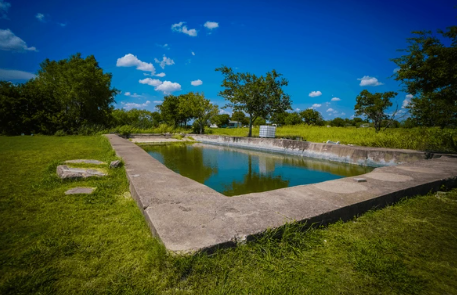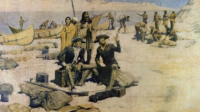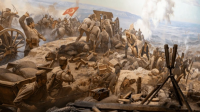The Waco Siege, also known as the Waco standoff, was a violent 51-day confrontation between the U.S. government and the Branch Davidians, a religious sect led by David Koresh. This standoff, which took place from February 28 to April 19, 1993, near Waco, Texas, ended in tragedy when the Branch Davidian compound was engulfed in flames, leading to the deaths of 76 people. The Waco Siege remains one of the most controversial events in American history, raising questions about government overreach, religious freedom, and the use of force. In this article, we will explore the background, key events, and long-term impact of the Waco Siege.
Read Also : The Marbury v. Madison Case (1803): Establishing Judicial Review in American Law
Introduction to the Waco Siege
The Waco Siege was the culmination of months of tension between the federal government and the Branch Davidians, a small religious group that had separated from the Seventh-day Adventist Church. Led by David Koresh, the Branch Davidians believed in an apocalyptic vision of the end times and were stockpiling weapons in preparation for a coming battle. Concerns over the group’s activities led to an investigation by the Bureau of Alcohol, Tobacco, and Firearms (ATF), which eventually resulted in the tragic standoff.
The Rise of David Koresh and the Branch Davidians
David Koresh, born Vernon Wayne Howell, emerged as the leader of the Branch Davidians in the 1980s. He claimed to be the final prophet and believed that he had been chosen by God to lead his followers through the apocalyptic end times. Koresh’s teachings centered around a unique interpretation of the Bible, with a focus on the Book of Revelation. His followers believed that Koresh had divine authority and would guide them to salvation.
Under Koresh’s leadership, the Branch Davidians established a compound near Waco, Texas, known as the Mount Carmel Center. This compound became the group’s spiritual and physical stronghold, where they lived communally and prepared for the coming of the end times. Koresh’s control over the group was absolute, and he implemented strict rules regarding marriage, sex, and daily life.
The rise of David Koresh and the Branch Davidians attracted attention from both the media and law enforcement, particularly due to allegations of illegal firearms stockpiling and child abuse within the compound. These concerns ultimately led to the government’s decision to take action against the group.
The ATF Investigation and Initial Raid
The Bureau of Alcohol, Tobacco, and Firearms (ATF) began investigating the Branch Davidians in 1992 after receiving reports that the group was illegally stockpiling weapons and explosives. The ATF believed that Koresh and his followers were in violation of federal firearms laws, and they sought to execute a search warrant on the compound to seize the weapons and arrest Koresh.
On February 28, 1993, the ATF launched a raid on the Mount Carmel Center, hoping to catch the Branch Davidians by surprise. However, the raid quickly escalated into a gunfight when shots were fired from both sides. Four ATF agents were killed, and several others were injured. The Branch Davidians also suffered casualties, with five members of the group dying in the initial confrontation.
The failed raid marked the beginning of the 51-day standoff between the Branch Davidians and federal authorities. Following the raid, the FBI took over the operation, initiating a prolonged siege that would ultimately end in tragedy.
The 51-Day Standoff: Negotiations and Escalation
Following the ATF’s failed raid, the FBI took control of the operation and initiated negotiations with David Koresh and his followers. Over the course of the next 51 days, negotiators attempted to persuade Koresh to surrender peacefully, while law enforcement maintained a perimeter around the compound and cut off access to essential supplies.
Koresh initially showed a willingness to negotiate, allowing several children and elderly individuals to leave the compound. However, as the standoff dragged on, tensions escalated. Koresh remained defiant, insisting that he and his followers were prepared to die for their beliefs. He claimed to be waiting for a divine signal before surrendering and continued to preach to his followers inside the compound.
The FBI, growing frustrated with the lack of progress, began increasing pressure on the Branch Davidians. They deployed psychological tactics, including blasting loud music and shining bright lights on the compound at night. These measures were intended to wear down the group’s resistance, but they also heightened tensions and contributed to the deteriorating situation inside the compound.
The Final Assault and the Deadly Fire
On April 19, 1993, after weeks of failed negotiations, the FBI made the decision to end the standoff with a final assault on the compound. Using armored vehicles, the FBI began inserting tear gas into the buildings in an attempt to force the Branch Davidians to surrender. However, instead of leading to a peaceful resolution, the operation ended in disaster.
Shortly after the tear gas was introduced, fires broke out inside the compound. The source of the fires remains a subject of controversy, with some claiming that the Branch Davidians set the fires themselves, while others argue that the fires were accidentally ignited by the government’s actions. Regardless of the cause, the flames quickly consumed the compound, trapping dozens of people inside.
In total, 76 Branch Davidians, including David Koresh, died in the fire. Many of the victims were women and children who had remained inside the compound throughout the siege. The tragic outcome of the Waco Siege shocked the nation and led to widespread criticism of the government’s handling of the situation.
Public Reaction and Media Coverage
The Waco Siege became a media sensation, with news outlets providing extensive coverage of the standoff and its tragic conclusion. Public opinion was deeply divided, with some supporting the government’s actions and others condemning what they saw as excessive force and government overreach.
The media’s portrayal of the Branch Davidians as a dangerous cult fueled public fears about extremist religious groups, but it also raised questions about the government’s handling of the situation. Many critics argued that the government’s use of military-style tactics was inappropriate and contributed to the loss of life.
The Waco Siege also had a lasting impact on the public’s perception of federal law enforcement agencies, particularly the FBI and ATF. The events at Waco became a rallying point for anti-government groups and contributed to the rise of the militia movement in the United States.
The Aftermath: Investigations and Accountability
In the aftermath of the Waco Siege, multiple investigations were launched to determine what went wrong and who was responsible for the tragic outcome. Congress held hearings on the siege, and the Justice Department conducted its own internal review. These investigations sought to understand the failures in both the planning and execution of the operation.
The government’s response to the Waco Siege was heavily criticized, with many questioning whether the use of force was justified and whether more could have been done to avoid the loss of life. Some investigators concluded that the FBI’s decision to escalate the situation by using tear gas was a critical mistake that contributed to the deadly fire.
Despite the numerous investigations, no federal officials were held criminally responsible for the deaths at Waco. However, the Waco Siege left a lasting legacy of mistrust between certain segments of the American public and the federal government.
The Long-Term Impact on Law Enforcement and Policy
The Waco Siege had a profound impact on law enforcement practices and policies in the United States. In the years following the siege, federal agencies such as the FBI and ATF made significant changes to their approach to standoffs and crisis situations. The emphasis shifted toward de-escalation and negotiation, with a greater focus on preventing the use of force unless absolutely necessary.
The Waco Siege also had a lasting effect on public attitudes toward the federal government, particularly among anti-government groups and militia movements. The siege became a symbol of government overreach and fueled resentment among those who believed that the government had violated the rights of the Branch Davidians. This mistrust of government would later be echoed in other events, such as the Oklahoma City bombing in 1995, which was carried out by individuals motivated in part by the Waco Siege.
The lessons learned from Waco continue to influence law enforcement practices today, as agencies strive to balance the need for public safety with the protection of civil liberties. The tragic events of 1993 serve as a reminder of the potential consequences of government actions and the importance of careful decision-making in crisis situations.
The Legacy of the Waco Siege
The legacy of the Waco Siege extends far beyond the tragic loss of life at the Mount Carmel compound. The events at Waco continue to shape public perceptions of government power, religious freedom, and the limits of law enforcement authority. In this section, we will explore the lasting legacy of the Waco Siege and its impact on American society.
The Siege as a Catalyst for Anti-Government Sentiment
The Waco Siege became a rallying cry for anti-government activists and militia groups across the United States. For many, the events at Waco symbolized the dangers of unchecked government power and the potential for government agencies to overstep their authority. The siege, along with the earlier events at Ruby Ridge in 1992, fueled a growing distrust of the federal government and inspired a wave of anti-government sentiment.
This sentiment found expression in the rise of the militia movement, which saw a surge in membership in the years following the Waco Siege. Militia groups, many of which were opposed to perceived government overreach, viewed Waco as evidence that the government was willing to use force against its own citizens. The siege became a symbol of resistance to government tyranny and was frequently cited by those who advocated for the right to bear arms and resist federal authority.
The legacy of Waco continues to influence anti-government rhetoric and activism today. The events of 1993 serve as a reminder of the deep divisions that can arise between the government and certain segments of the population, particularly when issues of religious freedom and civil liberties are at stake.
The Religious and Cultural Significance of the Siege
The Waco Siege also had significant religious and cultural implications. The Branch Davidians, though a small and obscure religious group, became the subject of intense scrutiny and public debate in the aftermath of the siege. The media’s portrayal of the group as a dangerous cult led to widespread misconceptions about their beliefs and practices, and the tragic outcome of the siege raised important questions about religious freedom and government intervention.
For many religious groups, the Waco Siege was seen as a cautionary tale about the dangers of government interference in religious matters. The siege highlighted the challenges that arise when law enforcement agencies engage with unconventional religious groups, particularly when those groups are viewed as a threat to public safety. The events at Waco underscored the importance of protecting religious freedom while also ensuring that law enforcement agencies respect the rights of individuals to practice their faith without fear of persecution.
The cultural impact of the Waco Siege can be seen in the numerous books, documentaries, and films that have been produced about the events of 1993. The siege has become a part of the broader cultural narrative about the relationship between government and religious groups, and it continues to be a subject of fascination and debate.
Waco and the Evolution of Law Enforcement Practices
One of the most significant legacies of the Waco Siege is its impact on law enforcement practices. In the years following the siege, federal agencies such as the FBI and ATF implemented significant changes to their approach to standoffs and crisis situations. These changes were aimed at preventing the kind of escalation that occurred at Waco and ensuring that future operations were conducted with a greater emphasis on de-escalation and negotiation.
The lessons learned from Waco have had a lasting impact on how law enforcement agencies handle similar situations today. Crisis negotiators are now given a more prominent role in standoffs, and the use of force is seen as a last resort rather than a primary option. Law enforcement agencies have also developed more comprehensive training programs to prepare officers for the complexities of dealing with religious and extremist groups.
The Waco Siege serves as a reminder of the importance of careful planning and decision-making in law enforcement operations. The tragic outcome of the siege has led to a greater awareness of the potential consequences of using force in crisis situations, and it has prompted law enforcement agencies to prioritize the preservation of life whenever possible.
Media Representation and Public Memory of Waco
The media played a central role in shaping public perceptions of the Waco Siege, both during the standoff and in the years that followed. News coverage of the siege was extensive, with many outlets portraying the Branch Davidians as a dangerous cult and David Koresh as a manipulative leader. This portrayal influenced public opinion and contributed to the belief that the government’s actions were justified.
However, in the years following the siege, a more nuanced understanding of the events began to emerge. Documentaries, books, and investigative reports have sought to uncover the truth about what happened at Waco, challenging the initial media narrative and raising questions about government accountability. Public memory of the Waco Siege remains divided, with some viewing it as a necessary law enforcement action and others seeing it as a tragic example of government overreach.
The legacy of the Waco Siege continues to be debated in the media and public discourse. The events of 1993 serve as a reminder of the power of the media to shape public perceptions of complex events, and they highlight the importance of critical thinking and skepticism in the face of government and media narratives.
The Broader Implications for Civil Liberties and Government Power
The Waco Siege had broad implications for civil liberties and the limits of government power. The events at Waco raised important questions about the government’s ability to use force against its own citizens and the potential for law enforcement agencies to overstep their authority. For many, the siege became a symbol of government overreach and a rallying point for those who believed that the federal government had too much power.
The legacy of Waco continues to influence debates about the balance between government authority and individual rights. The events of 1993 serve as a reminder of the importance of protecting civil liberties and ensuring that government actions are conducted in a manner that respects the rights of citizens. The lessons of Waco have been applied to other cases of government intervention, including debates about the use of force, surveillance, and the protection of religious freedom.
The broader implications of the Waco Siege are still felt today, as the events of 1993 continue to shape public attitudes toward government power and civil liberties. The siege remains a cautionary tale about the potential consequences of government actions and the need for accountability and transparency in law enforcement operations.
Conclusion: Reflecting on the Waco Siege
The Waco Siege was a tragic and controversial event that has left a lasting impact on American society. The standoff between the Branch Davidians and the federal government ended in a devastating loss of life, and the events of 1993 continue to influence public perceptions of government power, religious freedom, and law enforcement practices.
The Siege’s Place in American History
The Waco Siege occupies a significant place in American history, not only because of the tragic loss of life but also because of the broader questions it raised about the relationship between the government and its citizens. The events at Waco continue to be a subject of debate and reflection, as Americans grapple with the lessons of the siege and its implications for the future.
The Waco Siege serves as a reminder of the potential dangers of government overreach and the importance of protecting civil liberties. It also highlights the challenges that arise when law enforcement agencies engage with unconventional religious groups and the need for careful decision-making in crisis situations.
The Enduring Legacy of Waco
The legacy of the Waco Siege continues to shape public attitudes toward government power and civil liberties. The events of 1993 have had a lasting impact on law enforcement practices, religious freedom, and the broader cultural narrative about government intervention. The lessons of Waco remain relevant today, as Americans continue to navigate the balance between security and liberty in an increasingly complex world.
The Waco Siege stands as a cautionary tale about the potential consequences of government actions and the need for accountability, transparency, and restraint in the use of force. The tragic outcome of the siege serves as a reminder of the importance of protecting individual rights and ensuring that government power is exercised with care and consideration.
Looking Ahead: Lessons for the Future
As we look ahead, the lessons of the Waco Siege continue to resonate in debates about government power, civil liberties, and law enforcement practices. The events of 1993 serve as a reminder of the importance of protecting religious freedom, ensuring accountability in government actions, and upholding the principles of justice and fairness in the face of crisis.
The Waco Siege remains a defining moment in American history, one that continues to shape public attitudes and government policies. As we reflect on the events of 1993, we are reminded of the need for vigilance, caution, and a commitment to protecting the rights of all citizens, even in the most challenging and complex situations.
Frequently Asked Questions (FAQs)
1. What was the Waco Siege (1993)?
The Waco Siege was a 51-day standoff between the U.S. government and the Branch Davidians, a religious sect led by David Koresh. It took place from February 28 to April 19, 1993, near Waco, Texas, and ended in tragedy when the compound caught fire, killing 76 people.
2. Who was David Koresh?
David Koresh, born Vernon Wayne Howell, was the leader of the Branch Davidians. He claimed to be the final prophet and taught his followers that they were living in the end times. Koresh controlled the group with strict rules and religious teachings focused on the Book of Revelation.
3. Why did the government raid the Branch Davidian compound?
The ATF conducted a raid on the Branch Davidian compound after receiving reports that the group was stockpiling illegal weapons and explosives. The government believed that Koresh and his followers were violating federal firearms laws, which led to the initial raid on February 28, 1993.
4. What caused the fire that ended the Waco Siege?
The cause of the fire that destroyed the Branch Davidian compound remains a subject of controversy. Some believe that the Branch Davidians set the fire themselves, while others argue that the fire was accidentally ignited during the FBI’s final assault, which involved the use of tear gas.
5. What impact did the Waco Siege have on law enforcement practices?
The Waco Siege led to significant changes in law enforcement practices, particularly in how federal agencies handle standoffs and crisis situations. The emphasis shifted toward de-escalation and negotiation, with a greater focus on preventing the use of force unless absolutely necessary.







I wanted to jot down a simple word so as to thank you for those awesome guidelines you are posting on this site. My incredibly long internet investigation has at the end of the day been rewarded with incredibly good points to exchange with my contacts. I would express that many of us website visitors actually are truly blessed to exist in a magnificent network with very many marvellous professionals with good points. I feel pretty blessed to have come across your entire webpages and look forward to really more enjoyable minutes reading here. Thank you once more for a lot of things.